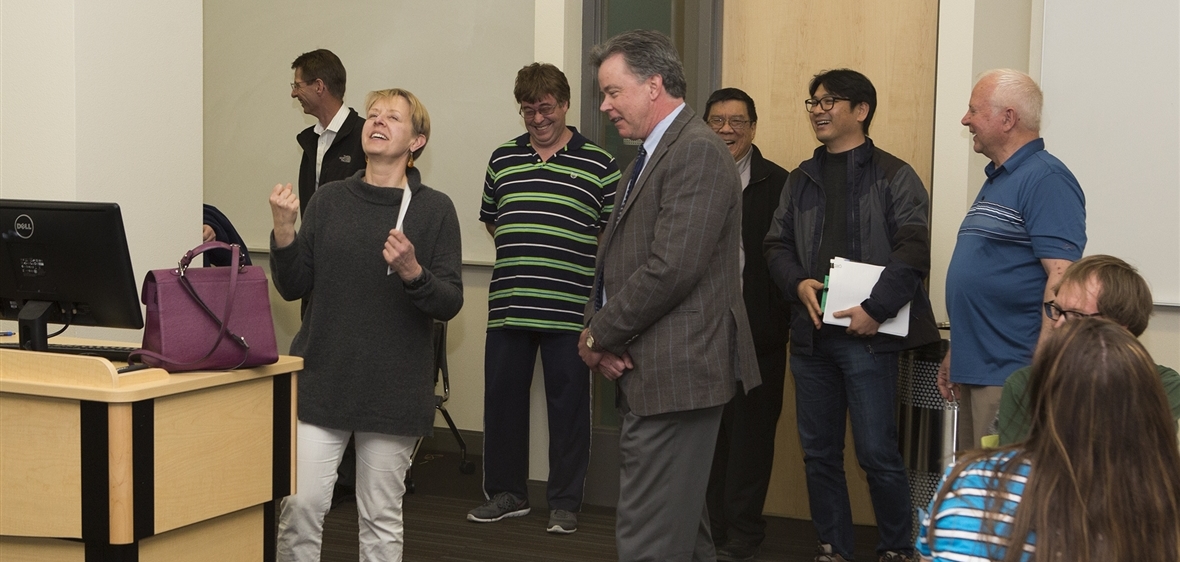During award presentation ceremonies in April, the University's two Tibbitts Awards winners were honored for their work in the classroom.
Both Tamara Scronce, an associate professor of Art, and Patricia Ellison, an associate professor of Biochemistry and Molecular Biology, were caught off-guard by the news.
Provost Kevin Carman, colleagues of the two professors, as well as members of the Tibbitts Award selection committee, interrupted classes that were being taught by the award winners. The F. Donald Tibbitts Distinguished Teacher Award has been conferred to the campus' finest teachers for more than four decades.
The reaction of each of the award winners?
Ellison, in the midst of a lecture on enzyme kinetics in a large lecture room in the William N. Pennington Student Achievement Center, was at a loss for words, something her longtime Department of Biochemistry colleague and mentor Gary Blomquist noted.
"I think," Blomquist said with a wide grin to Ellison, "that this is the first time I've seen you at a loss for words." "This is a new situation for me ... without something specific to say," Ellison admitted. She turned to her students, and added, "The people I really want to thank are you guys. It's teaching you year after year and learning from you ... that's what makes it all so fun for me."
Scronce's award presentation was also memorable.
It might've been the first time in Tibbitts Award history that the winner was notified while teaching ... in a hallway, in the shadow of an overstuffed couch in the Jot Travis Building.
"Are you kidding me?" Scronce asked, smiling, when Carman and Co. walked into the hallway while Scronce was using the space to elicit dialogue and critique from her MFA and BFA advanced degree students regarding digital social media artwork created by one of the students.
"We have this opportunity to embarrass you a bit," Carman said with a laugh.
"This was difficult to do," added Scronce's longtime Department of Art colleague, Rebekah Bogard. "It was difficult to pin you down and schedule this presentation since we're ... in a hallway. I had to keep it secret for an entire week."
Without missing a beat, and pointing to the nearby couch, which had apparently been part of the discussion with her students, Scronce added, "It's been marked surplus, but they haven't been by to pick it up yet. So it's a very convenient place to hold class."
More seriously, Scronce said, "I have to say, going through this process, and having served on the Tibbitts committee before, I honestly never imagined this coming my way. I'm truly honored."
A few days after the presentations, both Ellison and Scronce had a chance to sit down between classes to reflect on the award and what it meant.
For Ellison, who joined the faculty in 2000 as a researcher working on smooth muscle biochemistry, the Tibbitts Award was a reminder of her evolution as a professor. The native of England hadn't necessarily always thought of herself as a "teacher" - and hadn't taught at all - when she came to the University. Almost by happenstance, when a faculty member went on sabbatical in 2004 and her teaching load increased, did she feel that something "clicked." Shortly thereafter, she accepted an offer from her department to become a full-time teacher.
"I was surprised the first year I taught," Ellison said. She added, with a quick laugh, "It surprised me how patient I was. I was actually quite astonished. I could find reserves of patience and I caught on fairly quickly."
Ellison, who is known as a pretty forthright person, one who is known to crack the occasional "odd joke," even about biochemistry, said she learned to bring more alertness and enthusiasm to her teaching thanks to encouragement from colleagues such as Blomquist.
"When I first started teaching, the first two or three years, I was probably in his office (Blomquist was then the chair of the Department of Biochemistry and Molecular Biology) at least once a month," she said. "He listened to all my whining. From him, I got the idea of bringing energy to it. He was always so upbeat and energetic, and that certainly helped me, to learn from someone who really set a collegial, positive, energetic tone."
Scronce, too, said her process of becoming a teacher was one that has come in waves. In many ways, her career at the University, which began in 2000, is reflective of her work as an artist, and how that work has helped inform her teaching style.
"I'm engaged in contemporary art," said Scronce, who is a talented object maker with a passion for materials. "It's a given that in order to be an effective teacher, I have to be current in my own work. Really, in art, nothing stands still. My teaching has been an evolution. The art world helps keep it fresh for me."
Scronce said an attribute that she has cultivated in herself is her ability to listen. She said her teaching, often, is about "having the ability to find those moments of connection between the teaching, the student, the art, and helping the student find that very same connection. You have to be aware, and you have to be able to connect with the student."
She added: "What I've gotten better at has been listening, where my students are coming from ... to make the room for the connection."
Ellison, too, said listening well is an imperative if one is to teach well: "Over the last 12 or 13 years, I've really learned to listen. You really have to watch your students, and listen to them closely and carefully, to see if they are comprehending the material. You need to give them time and space to share what they've learned with you."
Scronce said she enjoys helping her students better understand their art study, and by doing so, to better understand who they are and what their capabilities as artists can be.
"I have this conversation with my students all the time," said Scronce, who in addition to her teaching and research duties, is also the Master of Fine Arts graduate director for her department, and also directs the sculpture program. "It seems kids decide very early on to become a doctor or a lawyer. With art, it's a much more evolutionary process of discovery. It takes time, but eventually one starts to think, 'Hey, maybe I can do this.' With my advanced students, that often leads to thinking about further advanced study. We talk all the time about figuring out a good path ... where they might take what they've learned into their future lives."
Ellison, who was herself a first-generation college student, though she enjoys all of her students, said she has particular empathy for students who come from a similar background.
"When I was growing up, college always felt a bit mysterious to me, like Mars," she said. "I have a lot of respect for the students that I recognize in my class who are maybe in a similar position. When I was in college, I often didn't feel comfortable approaching a professor. I recognize that common thread with the students in my classes who are first-generation college students.
"I know with my accent I sound like the principal of Hogwarts, but I can recognize the worry that some of my first-generation students have."
Scronce, also, said she has strong admiration for her students.
"There's not a whole lot of reason to study and make art unless you feel a passion for it," she said. "I think art students are some of our bravest students. People often say that art is so much fun, that it's creative and it sounds easy. But until you've actually endeavored to study art - which isn't the same as engaging in arts and crafts as a hobby - you find it's much more difficult and rigorous than you thought."
Although well-respected teachers are often honored because of their ability to inspire, to bring structure and meaning and knowledge to the classroom, Scronce said the reality is often not nearly as tidy.
She smiled when asked how she's able to maintain the proper professional/personal balance, particularly given she is an artist, and often has to create her own art with what time is left after her duties as a teacher, researcher and director in her department are completed.
"Am I well-balanced?" she asked. "No. It's hard to juggle everything. Of course, I can't be the teacher I am without being a professional practicing artist. I'm one that is greatly motivated by, engaged in, and genuinely moved by, the teaching process. So much of what I do as an artist contributes to my teaching, and vice-versa. In the portfolio I submitted to the Tibbitts committee, I did say one of my greatest challenges is balance."
Then Scronce shrugged her shoulders. "I'm a first-born, female Virgo," she said, with a smile. "I guess when you add it all up, if I say 'Yes,' to any task, committee, or project, I'm usually all-in."
Perhaps that would be the best way to describe both of this year's Tibbitts Award winners. Although they teach in different fields, and one sometimes might wander into a hallway to engage in rigorous, critical discussion, while the other might sound like one of the wise characters from Harry Potter but actually might have more personally in common with the students struggling with their college environment, both Patricia Ellison and Tamara Scronce are at their core teachers.
They are passionate teachers -- teachers who make every class they teach count.
When given a choice of how to describe what they do, both gave the same answer.
"Whenever anyone asks me what I do, I tell them I teach ... I teach biochem at UNR," Ellison said.
Said Scronce: "The easiest answer and the most consistent answer: I teach at the University. And then when they ask, 'What do you teach?' I have to get into that whole complicated art thing."












